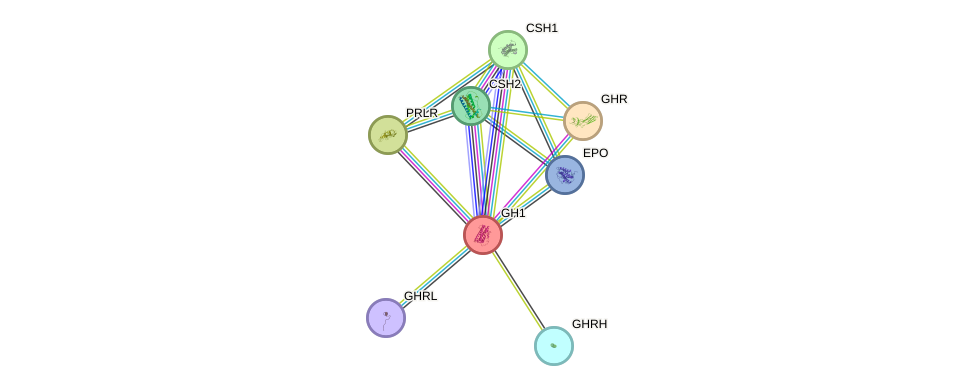GenAge entry for GH1 (Homo sapiens)
Entry selected based on evidence directly linking the gene product to ageing in a mammalian model organism
Gene name (HAGRID: 26)
- HGNC symbol
- GH1
- Aliases
- GH-N; GHN; GH; hGH-N
- Common name
- growth hormone 1
Potential relevance to the human ageing process
- Main reason for selection
- Entry selected based on evidence directly linking the gene product to ageing in a mammalian model organism
- Description
A secreted hormone crucial in growth control, GH1 (also known as somatotropin) stimulates IGF1 secretion. GH1 levels decline with age in humans and may contribute to loss of body mass [280]. Several results from model organisms, including rodents, suggest that the GH1/IGF1 axis plays a role in ageing. However, it is the attenuation of GH1/IGF1 activity that is associated with longevity in model organisms [286]. Transgenic mice overexpressing bovine GH1 are bigger than controls and may age faster [278]. Ames mice, which lack GH1 due to a mutation in PROP1, have increased health span and lifespan. Ames mice fed on a high fat diet are obese yet more insulin (INS) sensitive than control mice [4355]. Ames mice have been crossbred with mice lacking GHR, producing a new lineage lacking both GH1 and the GH receptor. These mice have improved glucose tolerance and increased adiponectin levels. Whilst these mice show the same increased longevity as their progenitors they do not show any further increases in longevity [4374]. In rats, moderate suppression of GH1 slightly extends lifespan while an extreme suppression leads to a shorter lifespan [287].
Growth hormone deficiency has been thought to diminish lifespan in humans [144]. However, it has been shown that GH1 secretion is diminished and tightly controlled in humans with familial longevity. Middle aged offspring of long living families were sampled, along with their partners as controls. No significant differences were observed in circulating levels of IGF1 and IGFBP3 [4362]. Despite its controversy, GH1 is a possible candidate for a gene playing a role in human ageing.
Cytogenetic information
- Cytogenetic band
- 17q24.2
- Location
- 63,917,193 bp to 63,918,852 bp
- Orientation
- Minus strand
Protein information
- Gene Ontology
-
Process: GO:0002092; positive regulation of receptor internalization
GO:0007259; JAK-STAT cascade
GO:0010535; positive regulation of activation of JAK2 kinase activity
GO:0014068; positive regulation of phosphatidylinositol 3-kinase signaling
GO:0015758; glucose transport
GO:0032355; response to estradiol
GO:0040018; positive regulation of multicellular organism growth
GO:0042517; positive regulation of tyrosine phosphorylation of Stat3 protein
GO:0042523; positive regulation of tyrosine phosphorylation of Stat5 protein
GO:0043406; positive regulation of MAP kinase activity
GO:0043568; positive regulation of insulin-like growth factor receptor signaling pathway
And 6 more GO terms Cellular component: GO:0005576; extracellular region
GO:0005615; extracellular space
GO:0005622; intracellular
Show all GO termsFunction: GO:0005131; growth hormone receptor binding
GO:0005148; prolactin receptor binding
GO:0005179; hormone activity
GO:0005515; protein binding
GO:0008083; growth factor activity
GO:0046872; metal ion binding
Protein interactions and network
Retrieve sequences for GH1
Homologs in model organisms
No homologs found
In other databases
- LongevityMap
- This gene is present as GH1

